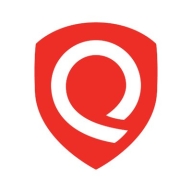

Qualys Web Application Scanning and Fortify on Demand are competitors in the web application security category. Qualys appears to have an upper hand with its integration capabilities and effective scanning, while Fortify on Demand excels in comprehensive dashboard offerings and multiple scanning types.
Features: Qualys Web Application Scanning integrates with Selenium IDE, automates login processes, and provides zero-day vulnerability protection with high accuracy. It integrates seamlessly with CI/CD pipelines. Fortify on Demand offers strong source code and dynamic scanning with a comprehensive vulnerability dashboard, supports diverse scanning types, and integrates with various development platforms.
Room for Improvement: Qualys Web Application Scanning needs to enhance its detection of XSS vulnerabilities, improve API integration, and make reports more flexible. Its UI complexity and false positives are also noted. Fortify on Demand should reduce false positives, expand language support, and improve cloud and on-premises integrations along with enhancing user experience on the dashboard.
Ease of Deployment and Customer Service: Qualys offers flexible cloud-based deployment but requires complex configurations at times. While customer service is generally favorable, some users experience challenges with support transactionality. Fortify on Demand is praised for its varied deployment modes and strong integration but could improve support response and personalization.
Pricing and ROI: Qualys has a competitive pricing model, though some users find it expensive. Its licensing offers scalability and ROI is noted through scanning efficiency. Fortify on Demand is perceived as pricey; however, its robust features justify the cost. Pricing model flexibility, especially for subscription and scan-based options, is needed. Both solutions report positive ROI due to improved security and process efficiency.


Fortify on Demand is a web application security testing tool that enables continuous monitoring. The solution is designed to help you with security testing, vulnerability management and tailored expertise, and is able to provide the support needed to easily create, supplement, and expand a software security assurance program without the need for additional infrastructure or resources.
Fortify on Demand Features
Fortify on Demand has many valuable key features. Some of the most useful ones include:
Fortify on Demand Benefits
There are several benefits to implementing Fortify on Demand. Some of the biggest advantages the solution offers include:
Reviews from Real Users
Below are some reviews and helpful feedback written by PeerSpot users currently using the Fortify on Demand solution.
Dionisio V., Senior System Analyst at Azurian, says, "One of the top features is the source code review for vulnerabilities. When we look at source code, it's hard to see where areas may be weak in terms of security, and Fortify on Demand's source code review helps with that." He goes on to add, “Another reason I like Fortify on Demand is because our code often includes open source libraries, and it's important to know when the library is outdated or if it has any known vulnerabilities in it. This information is important to us when we're developing our solutions and Fortify on Demand informs us when it detects any vulnerable open source libraries.”
A Security Systems Analyst at a retailer mentions, “Being able to reduce risk overall is a very valuable feature for us.”
Jayashree A., Executive Manager at PepsiCo, comments, “Once we have our project created with our application pipeline connected to the test scanning, it only takes two minutes. The report explaining what needs to be modified related to security and vulnerabilities in our code is very helpful. We are able to do static and dynamic code scanning. When we are exploring some of the endpoints this solution identifies many loopholes that hackers could utilize for an attack. This has been very helpful and surprising how many vulnerabilities there can be.”
A Principal Solutions Architect at a security firm explains, “Its ability to perform different types of scans, keep everything in one place, and track the triage process in Fortify SSC stands out.”
PeerSpot user Mamta J., Co-Founder at TechScalable, states, "Almost all the features are good. This solution has simplified designing and architecting for our solutions. We were early adopters of microservices. Their documentation is good. You don't need to put in much effort in setting it up and learning stuff from scratch and start using it. The learning curve is not too much."
Qualys Web Application Scanning (WAS) is a fully cloud-based web application security scanner. The scanner will automatically crawl periodically and test web applications to discover potential vulnerabilities, including cross-site scripting (XSS) and SQL injection. The consistent testing equips the automated service to generate consistent results, lessen false positives, and offer the ability to scale to protect thousands of websites effortlessly.
Qualys Web Application Scanning is bundled with different scanning technology to carefully scan websites for malware infections and will send notifications to website owners to assist in preventing blacklisting and brand reputation damage. As digital transformation takes place in various organizations, Qualys WAS gives organizations the ability to track and document their web app security status through its interactive reporting capabilities.
Qualys WAS empowers organizations to remediate any web application vulnerabilities quickly. Some of the key tools offered are:
Benefits of Qualys Web Application Scanning
Qualys Web Application Scanning offers many benefits, including:
Reviews from Real Users
Qualys Web Application Scanning stands out among its competitors for a variety of reasons. Two of those reasons are its progressive scan and quick detection of vulnerabilities.
P.K., a senior software developer at a tech vendor, writes, "The feature that I have found most valuable is the progressive scan. It is good. It's done in 24 hours."
Nagaraj S., lead cybersecurity engineer at a tech service company, notes, "I have found the detection of vulnerabilities tool thorough with good results and the graphical display output to be wonderful and full of colors. It allows many types of outputs, such as bar and chart previews."
We monitor all Application Security Tools reviews to prevent fraudulent reviews and keep review quality high. We do not post reviews by company employees or direct competitors. We validate each review for authenticity via cross-reference with LinkedIn, and personal follow-up with the reviewer when necessary.